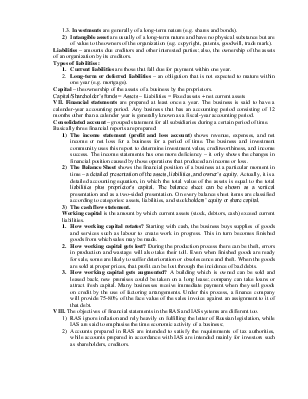


Accounting and financial statements
I. The actual record-making phase of accounting is usually called bookkeeping. Bookkeepers record every purchase and sale that a business makes, in order that they take place, in journals. Then, these temporary records are entered in or posted to the relevant account book or ledger. At the end of an accounting period, all the relevant totals are transferred to the profit and loss account. A double-entry bookkeeping records the dual effect of every transaction. Payments made or debits are entered on the left-hand (debtor) side of an account, and payments received or credits on the right-hand side. Bookkeepers will periodically do a trial balance to test whether both sides of an account book match. Also there are necessary documents – known as vouchers – that support or prove an item in an account, and make them available to the internal and external auditors who check the accounts.
II. Accounting is the art of organizing, maintaining, recording, and analyzing financial activities. Accounting is concerned with:
· the provision of information in financial terms that will help in decisions concerning resource allocation
· the preparations of reports in financial terms describing the effects of past resource allocation decisions.
However, accounting extends far beyond the bookkeeping. Accounting is concerned with the use to which these records are put, their analysis and interpretation.
Everyone uses accounting information. The manager of organization relies on the accounting information in order to make appropriate decisions. Investors in an enterprise need information about the financial status and future prospects of an organization. Bankers and suppliers grant loans and extend credits to organizations based on their financial soundness as evidenced by accounting information. Even customers and employees concerned about the condition of an organization make use of accounting information.
The human aspect in accounting arises because:
· most accounting reports depend on people’s opinions and estimates
· accounting reports are prepared in order to help people make decisions
· accounting reports are based on activities, which have been carried out by people.
III. The purpose of financial accounting is to provide information for external users. Stockholders and creditors are examples of people outside a company who want and need financial accounting information. They have to make decision to extend credit to a company or to invest in a company. They provide information on a company’s financial position, cash inflows and outflows, and the result of operations. Many companies publish these statements in an annual report, which distributed annually to its owners. The annual report also contains the independent auditor’s opinion for example information about the company’s activities, products, and plans.
Managerial accounting provides information to internal users, managers of a company. Internal management decisions can be classified into four major types:
1. Financial decisions – deciding what amounts of capital are needed to run the business.
2. Resource allocation decisions – deciding how the total capital of company is to be invested.
3. Production decisions – deciding what products are to be produced, by what means and when.
4. Marketing decisions – setting selling prices and advertising budgets; determining the location of a company’s markets and how to reach them.
Tax accounting - calculating an individual’s or a company’s liability for tax.
Cost accounting - working out the unit cost of products including materials, labour and other expenses.
Creative accounting – using all available accounting procedures and tricks to disguise the true financial position of a company.
Auditing – inspection and evaluation of accounts to determine whether the financial statements of a business fairly reflect the economic performance of the business.
Green accounting – taking into consideration ecological issues.
IV. Generally accepted accounting principles (GAAP)
Four Accounting Concepts:
1) Business Entity Concept (or Accounting Entity Concept) is the separate existence of the business organization. The records and reports of a business should not include either the transaction or assets of another business.
2) Continuity or Going-Concern Concept is the assumption that a business will continue to operate into the indefinite future and that the assets will not be sold.
3) Money Measurement or Unit-of-Measure Concept is recording and reporting economic activity in terms of a common monetary unit of measure.(e.g.dollar US)
4) Periodicity Concept is the assumption that an entity’s life can be meaningfully subdivided into time periods for purposes of reporting its economic activities.
Four Basic Accounting Principles:
1) Cost Principle requires assets and services to be recorded in the accounting records at cost.
2) Objectivity Principle requires that accounting records be based on verifiable events.
3) Revenue Principle states that revenue should be recorded at the time, but not before, it is earned.
4) Matching Principle requires that expenses be reported on the income statement in the same accounting period as are the revenues.
Four Further Over-Riding Principles:
1) Materiality Principle is the idea that the requirements of any accounting principle may be ignored if the effect on the financial statement is unimportant to financial statement readers.
2) Full-Disclosure Principle means that accounting financial statements should contain all relevant information about the operations and financial position of the entity and that information be presented in an understandable manner.
Уважаемый посетитель!
Чтобы распечатать файл, скачайте его (в формате Word).
Ссылка на скачивание - внизу страницы.